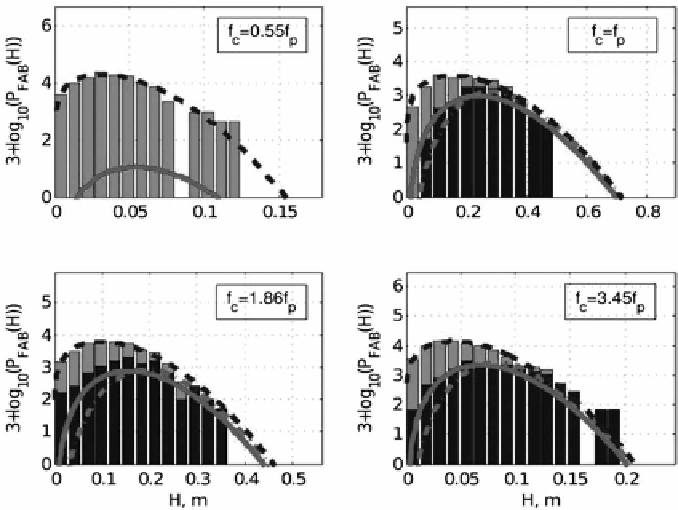Geoscience Reference
In-Depth Information
(circles), 1
45
f
p
(pluses). Filled circles present the Black Sea data
points, and diamonds Southern Ocean points - these points correspond to the spectral peak.
Overall agreement between the model and the data is very good, given the variety of data
and differences between the breaking mechanisms responsible for the observed breaking
probabilities. Within the individual frequency bins, however, some further sub-trends are
visible. These sub-trends were not picked up by the BWHD model, and they may be due
to different physical mechanisms in different frequency bands.
Indeed, below 3
f
p
, regardless of how diverse the breaking rates are, for example, at the
peak frequency for the Lake George and the deep-water records, the integrated BWHDs
tend to underestimate the observed breaking rates, and at 3
.
86
f
p
(triangles) and 3
.
45
f
p
these rates are overesti-
mated. This transition corresponds to the transition from breaking being due to inherent
reasons to the induced breaking as discussed above in this subsection.
Direct comparison of the
(5.43)
-
(5.46)
model with the data of record 5 (
Table 5.2
)is
shown in
Figure 5.32
. In this figure, histograms of the wave height distributions (light
colour) and the breaking wave height distributions (dark colour) are plotted and compared
with the Rayleigh distribution and with the model, respectively.
For the model, two options based on two different sets of the tunable parameters are
shown: the preferred option (
a
.
=
1
.
5 and
p
=
4) and one of the rejected options (
a
=
1 and
Figure 5.32 Wave height
H
distributions (light colour) and BWHD (dark colour) in the designated
frequency bins for record 5 of
Table 5.2
. The distribution values are denoted as
P
FAB
and plotted in
logarithmic scale. Rayleigh distribution is shown by dark dashed line and BWHD
(5.43)
-
(5.46)
with
light dashed line. The solid line indicates modelled BWHD with tunable parameters
a
=
1and
p
=
2.
Figure is reproduced from
Filipot
et al.
(
2010
) by permission of American Geophysical Union

Search WWH ::

Custom Search